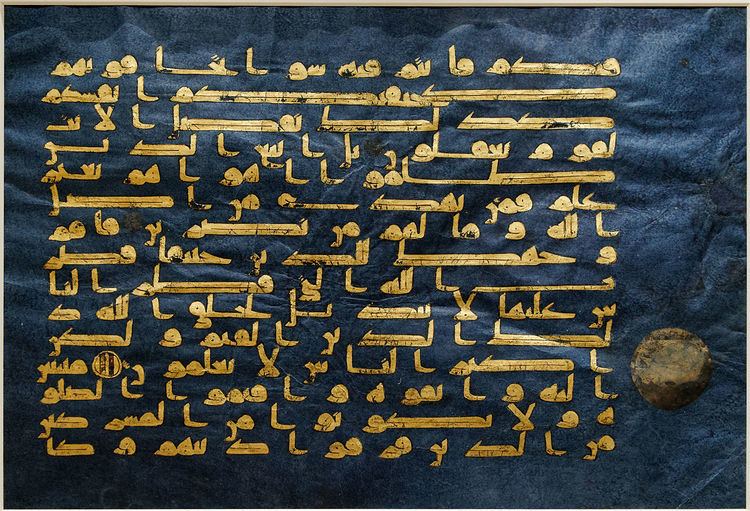 | ||
The Blue Qur'an (Arabic: المصحف الأزرق al-Muṣḥaf al-′Azraq) is a late 9th- to early 10th-century Fatimid Tunisian Qur'an manuscript in Kufic calligraphy, probably created in North Africa for the Great Mosque (Mosque of Uqba) of Qairawan. Although scholars generally agree on its provenance and dating, recent scholarship by Alain George dates the manuscript rather earlier, to the early Abbasid caliphate; however, it has been dated as late as 1020 CE and placed in Córdoba as well as Qairawan. It is written in gold and decorated in silver (that has since oxidized) on vellum colored with indigo, a unique aspect of a Quranic manuscript, probably emulating the purple parchment used for Byzantine Imperial manuscripts. Red ink is also used. It is among the most famous works of Islamic calligraphy, and has been called "one of the most extraordinary luxury manuscripts ever created." Art historian Yasser Tabbaa wrote that the "evanescent effect" of the gold lettering on indigo "appears to affirm the Mu'tazili belief in the created and mysterious nature of the Word of God."
The manuscript's approximately 600 pages were dispersed during the Ottoman period; today most of it is located in the National Institute of Art and Archaeology Bardo National Museum in Tunis, with detached folios in museums worldwide. These institutions include the Musée de la Civilisation et des Arts Islamiques in Raqqada, which has 67 folios. The folios are differently sized: the folio held by the Los Angeles County Museum of Art is 28.25 cm by 37.46 cm, but there are pages as large as 31 cm by 41 cm. Most of the folios remained in Qairawan until the 1950s, when they were further dispersed. In 2012 and 2013, folios from the Blue Qur'an were sold in major Islamic art auctions, carrying a price of hundreds of thousands of dollars apiece. Christie's of London sold folios in 2012 and Sotheby's in a record-breaking 2010 auction; the one folio auctioned by Sotheby's was reported sold for over $800,000, over double its estimated price. A note must be made, however, that Sotheby's published records do not show any folios sold that year.
Each sura's verses are demarcated in groups of 20 with silver rosettes and the text itself is inked in gold; the precious metallic text and rich indigo might have been a way for the Fatimid dynasty, which controlled North Africa at the time, to display its wealth, power, and religion in the face of the Byzantine Empire, which controlled Anatolia, and used gold or silver ink on purple parchment for its most lavish manuscripts. The gold ink was created by grinding gold and suspending it in a solution. The surrounding decoration of the mihrab of the Great Mosque of Cordoba is similar to and might have been the model for the Blue Qur'an's design. Contemporaneous manuscripts were often written on dyed parchment, particularly saffron-colored parchment, a holdover from the pre Islamic time. Though the method by which the Blue Qur'an was dyed remains unknown, Ibn Badis related the two contemporaneous methods of dying: dip-dying after the parchment was smoothed, or adding dye during the parchment production process. Given the brilliance of the color, it is likely that the parchment was dip-dyed before it was cured, impregnating it with the pigment. The Blue Qur'an is also one of the only extant Fatimid Qur'ans. Even older Qur'anic manuscripts are the Sana'a manuscript, Samarkand Kufic Quran, and Topkapi manuscript.
The Kufic script has sharp angles and is written in groups of 15 lines per page with no vowel markings, common characteristics in 9th- and 10th-century Islamic manuscripts. The comparatively large number of lines on each page deviates from the norm of other contemporaneous Qur'ans, such as the Amajur Qur'an, that dictated three lines per horizontal page. A column of letters is perceptible on the right side of each folio, created by the insertion of spaces called caesurae that put single letters at the beginnings of lines. Words with unconnected letters are occasionally split between lines in the manuscript, another common feature of Qur'ans from this period. The spacing of the letters has been described as "almost musical" and as "visual rhythm" by Robert Hillenbrand. Another unusual feature of this manuscript is visible mastara lines on some pages, used by the calligrapher to place the text.
A Maghribi script Qur'an manuscript written in gold on blue paper has been dated to the 13th or 14th century, inviting comparison to the Blue Qur'an. The Maghribi manuscript's parchment is a lighter tone than the Blue Qur'an and is more heavily decorated, having a foliage motif throughout.
